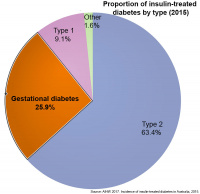Template:Main Page News: Difference between revisions
mNo edit summary |
mNo edit summary |
||
| Line 1: | Line 1: | ||
{| width=700px| | {| width=700px| | ||
|-bgcolor="CEDFF2" | |-bgcolor="CEDFF2" | ||
| <span style="font-size:150%"> | | <span style="font-size:150%">Australia - Gestational Diabetes (2015)</span> | ||
|-bgcolor="F5FAFF" | |-bgcolor="F5FAFF" | ||
| valign=top| [[File: | | valign=top| [[File:Australia - insulin-treated diabetes by type 2015.jpg|200px|right|alt=Australia - insulin-treated diabetes by type 2015|link=Australian_Statistics#Incidence_of_insulin-treated_diabetes_in_Australia_2015]] | ||
'''Proportion of insulin-treated diabetes by type (2015)''' The AIHW fact sheet provides the latest available national data on new cases of insulin-treated diabetes in Australia. | |||
It shows that in 2015 there were 28,775 people who began using insulin to treat their diabetes in Australia | |||
* 63% had type 2 diabetes | |||
* '''26%''' (18,142) had [[Abnormal Development - Maternal Diabetes|gestational diabetes]] | |||
* 9% had type 1 diabetes | |||
* 2% had other forms of diabetes or their diabetes status was unknown. | |||
In 2015, 7,405 women began using insulin to manage gestational diabetes—130 cases per 100,000 women of reproductive age (15–49 years), or around 1 in every 800 women aged 15–49. This represents almost 1 in 4 (24%) women diagnosed with gestational diabetes aged 15–49 in 2015. Gestational diabetes occurs when higher than normal blood glucose is diagnosed for the first time during pregnancy. It generally occurs in the second or third trimester, among women who have not previously been diagnosed with other forms of diabetes. | |||
:'''Links:''' [[ | Reference: AIHW 2017. Incidence of insulin-treated diabetes in Australia, 2015. Diabetes series no. 27. Cat. no. CVD 78. Canberra: AIHW. Viewed 20 February 2017 http://www.aihw.gov.au/publication-detail/?id=60129558632. | ||
:'''Links:''' [[Abnormal Development - Maternal Diabetes|Maternal Diabetes]] | [http://www.aihw.gov.au/publication-detail/?id=60129558632 AIWH Factsheet] | |||
|- | |- | ||
| | | | ||
:[[Template_talk:Main_Page_News|Older News Articles]] - [[Template_talk:Main_Page_News#August|Dolly's sisters live on!]] | [[Template_talk:Main_Page_News#June|Thalidomide in Zebrafish]] | [[Template_talk:Main_Page_News#March|Human pancreas stem cells]] | [[Template_talk:Main_Page_News#January|Oral contraceptive no risk of major birth defects]] | [[Template_talk:Main_Page_News#September|Maternal Malaria Neurovascular Development Effects]] | [[Template_talk:Main_Page_News#June|Oocyte/Spermatozoa fate decision]] [[Template_talk:Main_Page_News#April|Rubella eliminated in the Americas]] | [[Template_talk:Main_Page_News#February|Three-person embryos]] | :[[Template_talk:Main_Page_News|Older News Articles]] - [[Template_talk:Main_Page_News#September|Embryonic Development - Kyoto eBook]] | [[Template_talk:Main_Page_News#August|Dolly's sisters live on!]] | [[Template_talk:Main_Page_News#June|Thalidomide in Zebrafish]] | [[Template_talk:Main_Page_News#March|Human pancreas stem cells]] | [[Template_talk:Main_Page_News#January|Oral contraceptive no risk of major birth defects]] | [[Template_talk:Main_Page_News#September|Maternal Malaria Neurovascular Development Effects]] | [[Template_talk:Main_Page_News#June|Oocyte/Spermatozoa fate decision]] [[Template_talk:Main_Page_News#April|Rubella eliminated in the Americas]] | [[Template_talk:Main_Page_News#February|Three-person embryos]] | ||
|} | |} | ||
Revision as of 09:54, 20 February 2017
| Australia - Gestational Diabetes (2015) |
|
Proportion of insulin-treated diabetes by type (2015) The AIHW fact sheet provides the latest available national data on new cases of insulin-treated diabetes in Australia. It shows that in 2015 there were 28,775 people who began using insulin to treat their diabetes in Australia
In 2015, 7,405 women began using insulin to manage gestational diabetes—130 cases per 100,000 women of reproductive age (15–49 years), or around 1 in every 800 women aged 15–49. This represents almost 1 in 4 (24%) women diagnosed with gestational diabetes aged 15–49 in 2015. Gestational diabetes occurs when higher than normal blood glucose is diagnosed for the first time during pregnancy. It generally occurs in the second or third trimester, among women who have not previously been diagnosed with other forms of diabetes. Reference: AIHW 2017. Incidence of insulin-treated diabetes in Australia, 2015. Diabetes series no. 27. Cat. no. CVD 78. Canberra: AIHW. Viewed 20 February 2017 http://www.aihw.gov.au/publication-detail/?id=60129558632.
|
|
